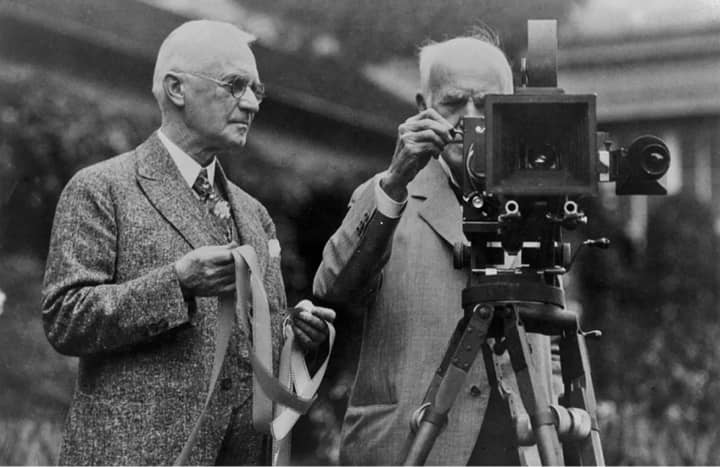
Emotions in Video Storytelling: Evolution and Emotional Engagement
Did you know that video technology has come a long way since the early days of mechanical television systems? Emotions in video storytelling have evolved alongside these advancements, transforming the way we tell stories, evoke emotions, and connect with audiences.

The Evolution of Video Technology
In the early days, videos were mostly used for live streaming and couldn't be easily recorded. However, in 1951, Charles Ginsburg and his team at Ampex Corporation created one of the earliest videotape recorders, allowing the capture and storage of live images.
Over time, Video recorders became more accessible to the public. Today, video is an integral part of cinema and digital filmmaking.

History says that before video technology, the Lumiere Brothers created the cinematograph, which was an important invention for movies. Now, with the advancements in video, it has become an important part of cinema.
Did you know that in just one second of video, there are 30 frames?

That's equivalent to approximately 30,000 words! When you multiply the 30,000 words by the length of your video, you'll get an impressive word count that reflects the total amount of information conveyed in the video.
Studies show that viewers retain more than 95% of a message when they watch it in a video, compared to just 10% when they read it in text. That's a remarkable difference in information retention.
Even though your video may not contain any spoken words, it communicates much more. It conveys thoughts, emotions, connections, memories, and feelings beyond mere text.

The Power of Facial Expressions in Conveying Emotions
Facial expressions and emotions are deeply interconnected. Our faces are highly expressive and play a crucial role in conveying and communicating our emotions to others. When we experience an emotion, such as happiness, sadness, anger, or surprise, our facial muscles naturally respond by forming specific expressions that are associated with those emotions.
In the context of videos, facial expressions play a crucial role in conveying emotions to the viewers. Actors use their facial expressions to portray various emotional states, bringing the characters and their stories to life. As viewers, our mirror neurons are triggered when we watch these facial expressions, leading to ‘emotional contagion’.
Can Videos Evoke Emotion and Make You Feel What They Show?
Emotional contagion refers to the phenomenon where we tend to "catch" and mirror the emotions of others, particularly when we observe their emotional expressions. For example, when we watch an actor crying in a video, our brain is wired to resonate with that emotion, making us more likely to experience a similar emotional response.
This means that we are more likely to experience and feel the same emotions as the characters on the screen. The power of facial expressions in videos allows us to emotionally connect with the story and the characters.
Age doesn't matter, everyone loves a good story.

The Impact of Storytelling
Videos consist of various components, including visuals, audio, and text, that work together to create a memorable experience for viewers. However, beyond these aspects, the essence of a compelling video lies in storytelling. Storytelling is crucial in videos as it helps convey messages, engage emotions, and connect with the audience on a deeper level.
Videos have a special power to touch our emotions and inspire us by telling stories that reflect the essence of human experiences. They leave a deep impression on our hearts and minds.
Videos create impactful visual experiences in diverse fields. In advertisements, videos are more interesting than static ads. It's rooted in basic human psychology. As we discover the many different ways videos can be used, we start to see how they can make our lives simpler and better in ways that truly matter. They have the potential to bring joy, knowledge, and inspiration into our lives, making a meaningful impact that stays with us.
One of the leading companies which empowers video creation explains in a video that great video content should have the four E's: Engaging, Emotional, Educational, and Empathetic.
Colors play a significant role in evoking specific emotions, which is crucial to consider in video marketing. According to a study, customers form their opinions about a product within just 90 seconds, and a significant portion (62-90%) of that judgment is influenced by the color of the product.

However, emotions hold even greater sway when it comes to captivating viewers through video content. Facial expressions, storytelling techniques, and the ability to evoke emotions are essential factors that make video ads so engaging and impactful.
Drawing upon historical evidence, we can delve deeper into understanding the role of emotions in videos and how they have been used effectively throughout time to leave a lasting impression on audiences.
Let's explore this fascinating aspect further.

The Role of Emotions in Videos: Historical Evidence
- Early Cinematic Era: In the early days of cinema, silent films used expressive facial expressions and storytelling through visuals to make audiences feel emotions. Actors like Charlie Chaplin and Buster Keaton were masters at expressing emotions through their physical performances, captivating viewers with both humor and heartfelt moments.
- The Golden Age of Hollywood: In the Golden Age of Hollywood during the 1930s and 1940s, films embraced sound to enhance emotional storytelling. Movies like "Gone with the Wind" and "Casablanca" used dialogue, music, and cinematography to evoke powerful emotions such as love, longing, and heartbreak, creating a profound connection with audiences that lasted.
Use our Video Emotion Recognition tool to generate multiple versions of your trailer and choose the most emotionally engaging one with our Emotion Highlights feature!
- Documentary Filmmaking: Documentaries have recognized the power of emotions in telling real-life stories and driving social change. In the 1960s, groundbreaking documentaries like "Nanook of the North" and "Hoop Dreams" captured the struggles and triumphs of individuals, creating empathy and inspiring action. Emotions played a crucial role in fostering understanding of complex social issues.
- Digital Age and Online Videos: In the digital age, video content has become easily accessible through platforms like YouTube. Online videos, whether they are short clips, vlogs, or web series, rely on emotions to captivate viewers in a competitive landscape. Emotional storytelling is key to success, as creators share personal stories, motivational content, or humor to connect with audiences on a deep emotional level.
Discover how our Emotion AI enhances every stage of filmmaking, from pre-production to post-production in our latest blog!
- Viral Videos: The internet era, with platforms like YouTube, TikTok, Twitter, and others, has popularized the spread of viral videos. Storytelling techniques, such as heartwarming narratives and humorous anecdotes, have a greater likelihood of becoming viral and evoking strong emotions among a wide online audience.
Platforms like YouTube Shorts, TikTok, Reels, and Twitter have become hotspots for emotional content that rapidly gains attention and resonates with users. These platforms provide a space where creators can share short videos that evoke strong emotions and engage viewers in unique and captivating ways.
To dive deeper into how emotions play a key role in viral content, check out our YouTube Shorts Emotion Analysis and Instagram Reels Emotion Analysis blogs for an in-depth look at emotional engagement on these platforms.
On the other hand, videos have transformed various industries and aspects of our lives, reaching audiences on a global scale. Let's take a closer look at some key areas where videos have made a significant impact.
- Entertainment Industry: Video-driven Creativity - Video plays a pivotal role in the entertainment industry, revolutionizing the way we consume content. Streaming platforms like Netflix, Hulu, and Amazon Prime Video offer a vast library of movies, TV shows, documentaries, and music videos, immersing audiences in captivating narratives and leaving a lasting impact on popular culture.
Analyze your auditions with our Emotion AI to discover the most emotionally resonant performance!
- Marketing and Advertising: Captivating Video Campaigns - Video advertisements have become a powerful tool for brand awareness and emotional connection. Brands leverage video commercials and social media ads on platforms like Facebook, Instagram, and YouTube to reach millions of users with engaging content, enhancing brand visibility and driving consumer engagement.
- Education and Training: Engaging Video-based Learning - Videos have transformed education and training, delivering knowledge effectively through e-learning platforms. Online courses, tutorials, and webinars utilize video content to create interactive and engaging learning experiences, making education accessible to learners worldwide.
- News and Journalism: Multimedia News Reporting - Online video platforms have expanded the reach of traditional news outlets. Websites like CNN, BBC, and Vice News feature video reports, interviews, and citizen journalism videos, providing comprehensive news experiences and shaping public opinion.
- Social Media and Personal Expression: Video-powered Connections - Video sharing platforms such as YouTube, TikTok, and Instagram's IGTV enable individuals to express themselves, share personal stories, and showcase talents. Vlogging and video diaries foster connections, build communities, and allow influencers to amass millions of subscribers through engaging video experiences.
Improve your screenplay by analyzing the emotional depth of your script with our Text Emotion Recognition tool!
From entertainment to education, marketing to news reporting, and personal expression to storytelling, videos have the power to connect with audiences emotionally.
A video speaks volumes, even when the words are few, as it harnesses the power of visuals, music, and storytelling to evoke emotions and leave a lasting impression. Whether it's the work of filmmakers bringing narratives to life or ad creators crafting compelling campaigns, the ability to invoke emotions through videos is what truly resonates with viewers.
Videos have a unique way of evoking emotions and it's important to analyze them closely. Let's analyze videos in depth and gain a deeper understanding of the emotions they evoke, to ensure they effectively convey their intended message.
Have you ever wished to decode the emotions captured in every video frame? With the revolutionary Emotion AI technology, that power is within our grasp.
Emotion AI empowers us to understand the emotions portrayed by actors and captured in every moment (frame) of a video. This groundbreaking technology offers precise emotional analysis, providing valuable insights into how videos truly impact viewers.
So, when we consider the power of video and its integration into various facets of our lives, it becomes evident that videos have become an indispensable part of our existence. Video technology's evolution has transformed storytelling, evoking powerful emotions and creating impactful visual experiences.
Facial expressions, storytelling, and Emotion AI technology contribute to their ability to connect, engage, and inspire across various fields. Videos harness visuals, audio, and storytelling to leave lasting impressions, shaping our human experiences.
Visit Imentiv AI to explore to explore case studies, blogs, and discover how our AI technology company can meet your specific business needs.